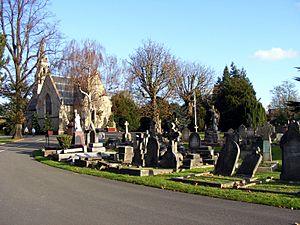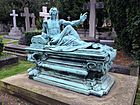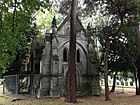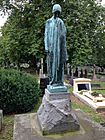East Finchley Cemetery facts for kids
East Finchley Cemetery is a special place in London where people are buried or cremated. It is located in East Finchley. Even though it is in the London Borough of Barnet, the City of Westminster looks after it.
Contents
History of the Cemetery
This cemetery started in 1854. It was first called St Marylebone Cemetery. Architects Barnett & Birch designed it on a large piece of land, about 47 acres (0.19 square kilometers).
Two tall Lebanon Cedar trees stand on the front lawn. A crematorium, a place where bodies are turned into ashes, opened here in 1937. The London Cremation Company now owns this crematorium. They also own several other crematoriums in England.
Over time, the cemetery's management changed. In 1965, the City of Westminster took over, and the cemetery got its current name. About 22,000 people have been buried here. The cemetery is still open for new burials today.
The cemetery has won awards for being a great green space. It received a Green Flag Award in 2007, 2008, and 2009. It is also important for nature, being a Site of Local Importance for Nature Conservation.
In the early 1990s, there was a disagreement about selling the cemetery. Some people thought it was too expensive to keep. The cemetery also had land used for growing plants for the City of Westminster. After much discussion, the cemetery was sold. This sale later became part of a larger issue known as the Westminster cemeteries scandal.
Many buildings and monuments in the cemetery are very old and important. They are listed on the National Heritage List for England. This means they are protected because of their history or special design.
Special Buildings and Monuments
The main Anglican chapel was designed by Barnett and Birch. It is a Grade II listed chapel. The crematorium building is also Grade II listed. Even the main gates and the lodge (a small house near the entrance) are Grade II listed.
Many monuments to famous people are also listed as Grade II. These include:
- The monument for Thomas Skarratt Hall. It used to have four bronze angels, but they were stolen in 1989.
- The monument for Harry Ripley, made by William Reid Dick.
- The monument for Peter Nicol Russell.
- The monument for Thomas Tate, made by Frank Lynn Jenkins.
- The mausoleum (a grand tomb) for Algernon Borthwick, 1st Baron Glenesk, his wife, and son. It was designed by Arthur Blomfield.
Famous People Buried Here

Many well-known people are buried or cremated at East Finchley Cemetery. Here are some of them:
- Melanie Appleby – A singer from the pop duo Mel and Kim.
- George Barham – He started the Express County Milk Company.
- Henry Walter Bates – A naturalist and explorer. He was the first to explain how animals use mimicry (looking like other animals).
- Jeremy Beadle – A TV presenter. He was cremated here, but his ashes are buried in Highgate Cemetery.
- Sir Henry Bishop – A music professor and composer of operas.
- Keith Blakelock – A police officer who was sadly murdered during a riot in Tottenham.
- Algernon Borthwick, 1st Baron Glenesk – He has a memorial chapel and mausoleum here.
- Sir James Boyton – A British estate agent and politician.
- Sir Austen Chamberlain – A Foreign Secretary and winner of the Nobel Peace Prize. He was the son of Joseph Chamberlain.
- Harry Champion – A famous Music Hall singer.
- Robert Donat – An actor.
- Matthew Garber – An actor.
- Sir Edmund Gosse – An English poet, author, and critic.
- William Gowland – An engineer and archaeologist who lived in Japan for many years.
- Thomas Skarratt Hall – An early investor in the Mount Morgan mine in Australia.
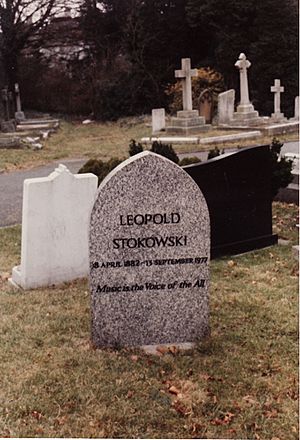
- Alfred Harmsworth, 1st Viscount Northcliffe – He started the Daily Mail newspaper.
- Cecil Harmsworth, 1st Baron Harmsworth – A British businessman and politician.
- Sir Robert Harmsworth – A newspaper publisher with a memorial designed by Edwin Lutyens.
- Harold Harrison – An England rugby player who died as an army Colonel in World War II.
- Sir George Hayter – The main painter for Queen Victoria.
- Max Herrmann-Neisse – An exiled German poet and novelist.
- Quintin Hogg (merchant) – An English merchant and philanthropist. He helped create the Royal Polytechnic institution, now the University of Westminster.
- Fanny Houston – A British philanthropist, political activist, and suffragette (someone who fought for women's right to vote).
- Thomas Henry Huxley – A famous scientist.
- Humphrey Lyttelton – An English jazz musician and broadcaster (cremated).
- Jimmy Nervo – An entertainer and part of the original Crazy Gang comedy group.
- Sir James Paget – An English surgeon and pathologist. A disease is named after him.
- Sidney Paget – The illustrator for Arthur Conan Doyle's Sherlock Holmes stories.
- Wendy Richard – An actress. She was cremated at Golders Green Crematorium.
- W. Heath Robinson – An artist and cartoonist.
- Gaynor Rowlands – An actress and singer.
- Sir Thomas Smith, 1st Baronet, of Stratford Place – A very important British surgeon. He was Surgeon Extraordinary to Queen Victoria.
- Henry Charles Stephens – An ink maker, philanthropist, and local Member of Parliament.
- Thomas Stevens – A cyclist who was the first person to ride a bicycle around the world.
- Marie Studholme – An actress and singer.
- Leopold Stokowski – A famous conductor.
- William Bernhardt Tegetmeier – An English naturalist and bee keeper, and a friend of Charles Darwin.
- Little Tich – A Music Hall singer and dancer.
- Mathilde Verne – An English pianist and teacher. She taught HM the Queen Mother.
- George Walters – A Sergeant who won the Victoria Cross (a very brave award) at the Battle of Inkerman in 1854.
- Kenneth Williams – An actor and comedian (cremated).
- Sir Arthur Worley – President of the British Insurance Association.
- Albert Yorke, 6th Earl of Hardwicke – A British diplomat and politician.
- Charles Yorke, 5th Earl of Hardwicke – Also known as Champagne Charlie, a British aristocrat and politician.
Vaslav Nijinsky, a famous dancer, was first buried here. Later, his body was moved to Montmartre Cemetery in Paris.
War Graves
The cemetery has graves for soldiers who died in wars. There are 75 graves for Commonwealth soldiers from World War I. Most of these are in a special area set aside for military burials in 1916. There are also 79 graves from World War II, including two British soldiers who could not be identified.
A special memorial wall lists the names of 20 World War II soldiers. They were cremated at the St Marylebone Crematorium. There are also special memorials for eight World War I servicemen whose graves could not be marked with headstones.
How to Get There
The cemetery is close to the North Circular Road (A406). It is located between East Finchley and Finchley Central stations. Both stations are on the Northern Line of the London Underground.
Gallery


